What will Abbotstown look like?
Sport Ireland recently submitted an application for planning permission to develop a cricket stadium in Dublin
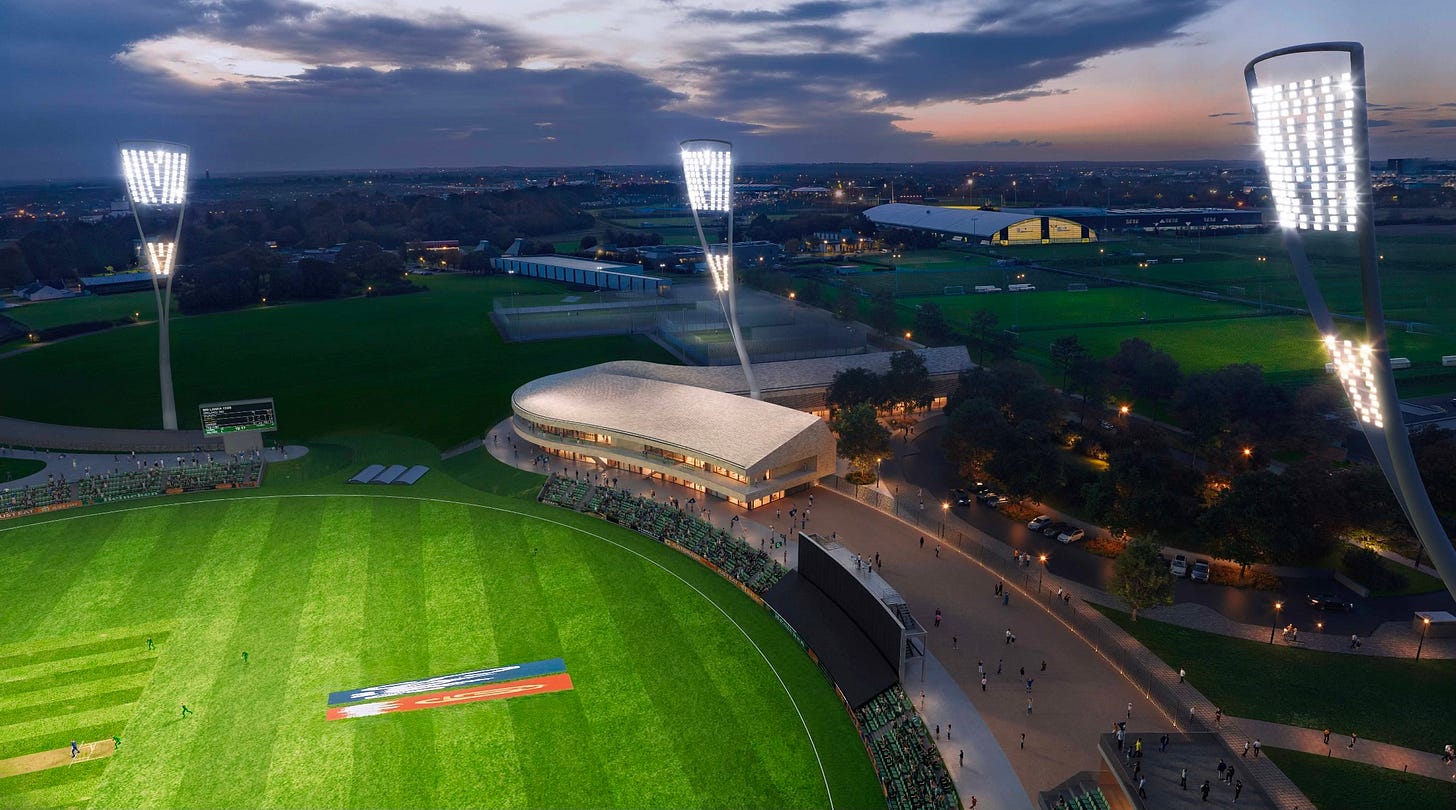
Eight months on from the government’s green light, we now have detailed plans of Cricket Ireland’s new stadium at Abbotstown.
On April 25th, Sport Ireland, the government agency which owns the complex on which the ground will be built, submitted a planning application to Fingal County Council. Cricket Ireland and their architects have had their say. The future of Ireland’s first ever national cricket facility is in the hands of the local authority.
Last August, the government announced their intention to build a 4,000 seater stadium by 2028. Have these plans told us anything that we didn’t already know?
The government previously committed to have design and planning completed by the end of Q2 this year. The wording from the ministers left it vague as to whether the planning phase included securing permission from the local council, or just applying for it. Given the application went in at the end of April, there is no way permission will be granted by the end of Q2.
Still, given this project’s lengthy history and Irish cricket’s view of deadlines as optional - remember we were told that there would be official word on the ETPL by the end of April? - to have 144 planning documents in the public domain is no bad thing.
The key details in the application confirm the previous figure of 4,000 permanent spectator seats - 4,240 to be precise. There is a desire to implement additional temporary seating to increase the capacity to 12,000 when needed. This is certainly with the 2030 T20 World Cup in mind. If you are a fan of attending games at Malahide, the delay in that club’s planning process in regards to improving their own facilities, combined with the desire to increase capacity at Abbotstown, would not leave you optimistic that the stated goal to keep ‘festival cricket’ on the Dart line will come to fruition. At least in the medium term.
Still, the designs at Abbotstown are stunning. The two-storey pavilion features the required player and match officials area (PMOA), the international spec changing rooms which aren’t in place at Malahide. These are what necessitate the expensive temporary infrastructure, more so than fan seating. There is also an indoor centre with four nets, a gym, physio room and offices for high performance staff.
There will be 16 wickets on the grass square, along with six floodlights around the ground. The latter is crucial, meaning white ball games can start at more sociable hours for supporters. There are plenty more details included. Those inclined to sift through every document can do so here.
Eagle eyed fans have spotted that these plans don’t match the less detailed picture which came as part of CI’s strategic plan last year. This is due mainly to the phased nature of the government’s funding commitment. In their original architect drawings done a number of years ago, CI asked for the sun, moon and stars. The government granted them a good bit less, with somewhat of a promise of more to come in later phases.
CI wanted 8,000 permanent seats with the option of growing to 20,000 when India comes to town. They planned for a nursery ground, a much larger pavilion and a media centre. Compare the two pictures below. You’ll see that a lot has changed. The pavilion is much narrower. The nursery ground won’t be built in phase one, nor will a permanent media centre - though current plans do ask for the “provision of a media/outside broadcasting zone for all event/match days”. The massive, MCG-style square boundaries have also been shortened in the latest drawings.

Concrete detail has been offered on plans to improve public transport links to the facility. At present, you’d be quicker flying to Lord’s than getting to Abbotstown without driving.
A bus terminus will be built to shuttle fans in, a new road system is also included while a number of car parking spots have been sought. These include accessible spaces and electric vehicle parking. Cue jokes about Teslas.
Irish Rail have submitted a document as part of the application, stating their willingness to put on shuttle bus services from the M3 Parkway train station on certain event days. One would imagine that this plan will be in place for the 2030 T20 World Cup, as opposed to Leinster Lightning home fixtures.
While the detail is welcome, it doesn’t allay every concern related to convenience. An intercity train to County Meath isn’t as straightforward as the Dart to north Dublin.
There are limited direct trains between the four main stations in Dublin city centre - Connolly, Pearse, Heuston and Tara St - and the M3 Parkway. Most routes call for a change at Boombridge up near Glasnevin Cemetery. Given it’s a 30 minute journey from there, the commute isn’t ludicrous - depending on the shuttle service on the other side. It’s less straightforward for our northern brethren, seeing as the Belfast-Dublin train has been known to stop at Malahide on matchdays. Now they’ll have to go into the city to head back out again.
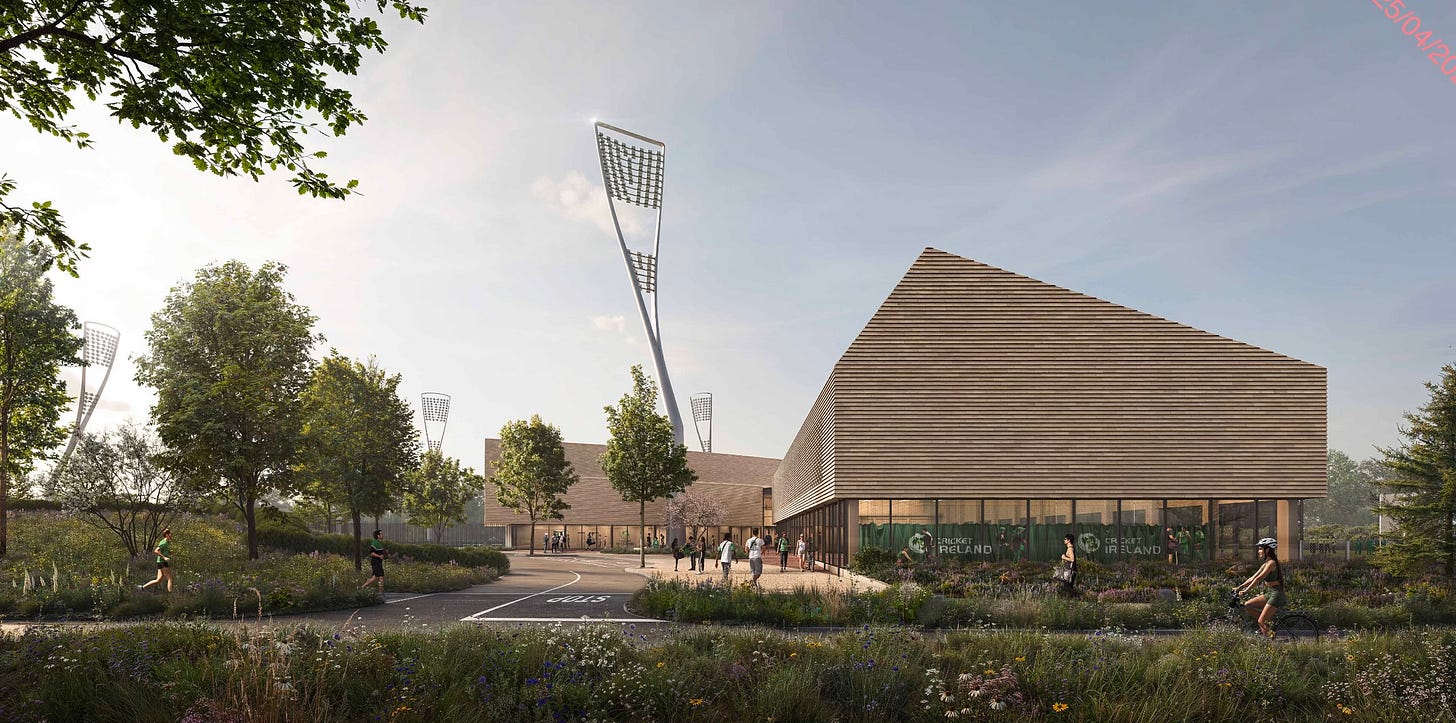
All told, the plans look sleek. I would have like to have seen more grass banks for spectators, creating a boutique feel similar to what you find in New Zealand, but it’s still inevitable for excitement to build at the prospect of watching Ireland games at a venue like this.
It should be pointed out that these designs were clearly not done by cricket people. In the below drawing, we can forgive the Irish players wearing jerseys which don’t match. The ‘keeper wearing a helmet while standing back is a bit harder to stomach. Second slip standing deeper than his colleague at first is a cardinal sin.
For some reason, Kumar Sangakkara is at the non-striker’s end (seriously, it actually is his name on the jersey). He last played first class cricket in 2017. Even he wants to come out of retirement for Abbotstown. His stance out of the crease, though, leaves him a prime mankad candidate. He might not stick around for long.
The square leg umpire - as opposed to his colleague at the bowler’s end - is holding a jumper, one which is a different colour from the green jerseys. The prospect of fans on the roof of the stand on the right hand side looks a recipe for drunken disaster. Imagine the Fionn Hand Appreciation Society boys up there.
Those short of a few quid for tickets will be delighted to see that the perimeter fence included in the below image doesn’t look completely impenetrable. Security will be beefed up, one would think, but if a see-through fence remains the order of the day, court-siders - those paid to relay live information for bookies to take advantage thanks to TV delays - will earn a lot of money.
On a more serious note, while the quality suffers, zooming in on the fans in the stands in the Sangakkara snap reveals tricolours being waved. Fans from south of the border always bring green, white and orange to Ireland games, and the colours adorned by CGI fans will have no bearing on Fingal’s planning decision. Yet their inclusion in publicly available pictures relating to an all-island sport is sloppy. Someone north of the border will notice.
There is also the curious presence of in-ground sponsorship on a number of designs. Aim big, for sure, but why include the logos of AIG, Heineken and Just Eat, companies which have no current relationship with Cricket Ireland or Sport Ireland? (The former can be seen between cover and extra cover when zooming in on the below pic. The latter two are more clearly visible on the top image.)
There will absolutely be high profile sponsors hoarding at World Cup games, though none of the above three companies sponsor the ICC either. Perhaps it made good PR sense not to include actual ICC partners, such as Aramco, the energy company run by the Saudi government.
Fingal County Council is not going to reject this application because whoever conjured up the CGIs was liberal with the truth on sponsors. It still seems a needlessly cheeky set of names to include. Someone appears to be overselling cricket’s commercial power in this country, unless CI has somehow managed to secure three bluechip sponsors without telling anyone.
It should be said that Sport Ireland, not CI, submitted the planning application and ultimately have responsibility for its contents. CI obviously had an input.
Regardless, this is all still a net positive. Ireland desperately needs a facility to call its own. Quirks of the plans provide both comic relief and confusion, but that doesn’t change the fact that completion of these designs is a significant moment.
Time and again, when listing the issues of Irish cricket, it all comes back to facilities. We are one step closer to the only thing which can solve a lot of crippling problems in one fell swoop.
Now we wait on the council.
Full planning permission details can be found here.
Permission and Retention Permission for proposed development consisting of:
1. Cricket oval (156 m diameter field of play), permanent fixed seating for 4,240 spectators with access from the northeast and southwest, and perimeter fencing.
2. Two storey (12 m high) main pavilion building (4,477 sqm) comprising High Performance Centre (HPC) including 4 lane indoor cricket hall with viewing gallery, hall storage, fitness suite, medical and consulting rooms and HPC offices; Player and Match Official Area (PMOA) comprising 4 no. team changing suites, internal and external viewing areas over the oval, team analysis area, physio room, players and coaches changing facilities and utility room, changing and support accommodation for officials, team and official dining room, and anti-doping suite; and foyer, admin staff area, staff room, toilets, and venue control room.
3. Cricket oval floodlighting via 6 no. columns of maximum height 60 m approximately.
4. The provision of spectator concourse and service zone/route immediately around the cricket oval seating; 2 no. moveable sightscreen frames; maintenance facility; and 2 no. toilet blocks.
5. Arrivals plaza including the provision of 31 no. car parking spaces (including 2 no. EV spaces and 7 no. accessible spaces and 1 no. shared EV/accessible space) and 15 no. bicycle parking spaces for day-to-day and non-event/match day use.
6. Provision to the north of the proposed access road of a permanent cricket facility energy centre, provision of a media/outside broadcasting zone for all event/match days; and (a) provision of 150 no. car parking spaces (of which 15 no. are for permanent use and 135 no. for event/match use up to 4,240 attendance, of which there are 18 no. EV spaces and 2 no. accessible spaces and 1 no. shared EV/accessible space) and 184 no. bicycle parking spaces; (b) provision of an event/match overlay area to accommodate a further 170 no. car parking spaces and further bicycle parking spaces for attendances in excess of 4,240 spectators.
7. Provision of serviced overlay areas to accommodate up to a further approximately 7,760 non-permanent seats required on an occasional basis (to bring the total occasional capacity to 12,000 seats) and for concessions, food and beverage, corporate activities, spectators’ activation zones for use only on match/event days, and provision of permanent utilities and services in the form of water, electricity and waste water.
8. Provision of new outdoor grass surface practice nets providing 16 strips, and retention permission of existing access, landscaping and 26 no. car parking spaces at the existing nets for use on a permanent basis.
9. New access road with new entrance incorporating totem signage, pedestrian crossing, carriageway, cycle lanes, footpaths, bus turning area, bus/taxi drop off area, bus lane reservation, upgrade to 2 no. existing pedestrian and bicycle crossings and junction improvements on Ballycoolin Road.
10. 8 no. bus/coach stops, bus and coach turning area/terminus, 30 no. bicycle parking spaces, upgrade and modification to existing vehicular roads, and widening and resurfacing of existing footpaths/cycleways, new gated pedestrian/cycle entrance to the south of the campus, provision of new cycle routes and footpaths promoting active travel into and within the campus.
11. Provision of temporary haul road to facilitate the construction of strategic drainage infrastructure.
12. Temporary provision of a construction compound for the proposed scheme north of the proposed access road prior to completion of the proposed development.
13. Reprofiling of land, extensive landscaping, necessary services and infrastructure, diversion and undergrounding of existing overhead power lines, 2 no. substation kiosks and transformers, and all associated site works above and below ground including temporary works required to facilitate the efficient and safe ongoing operation of the campus.


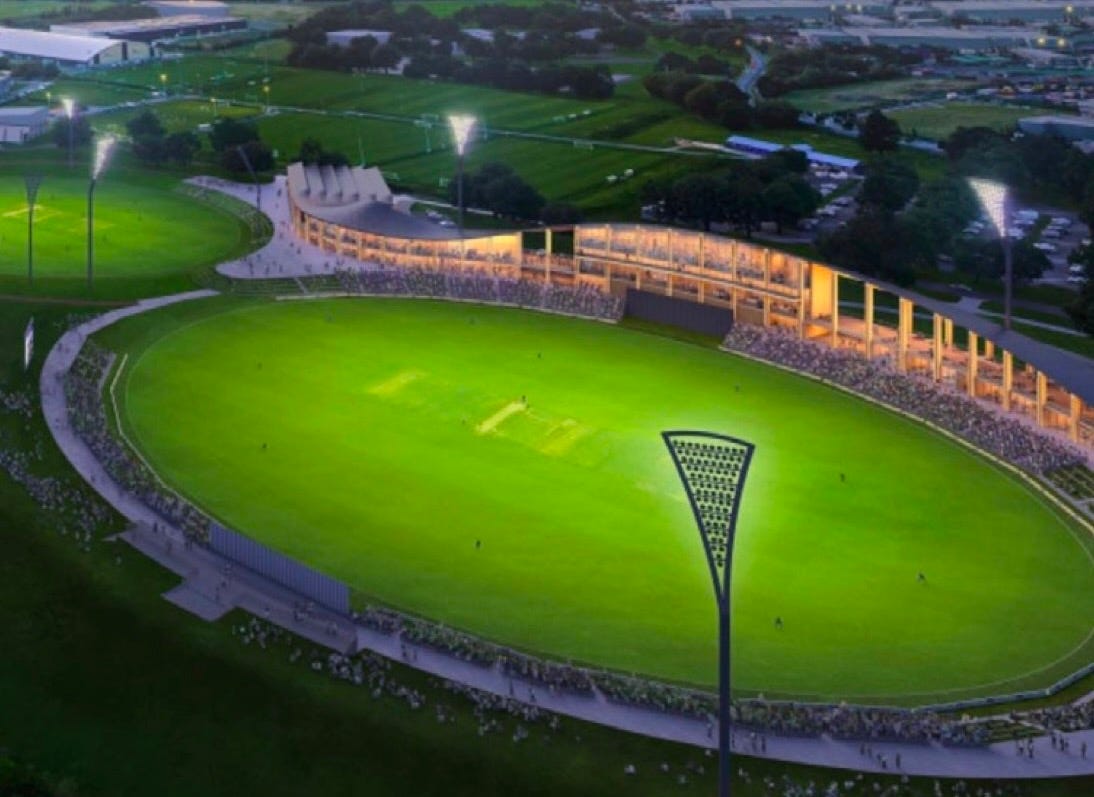
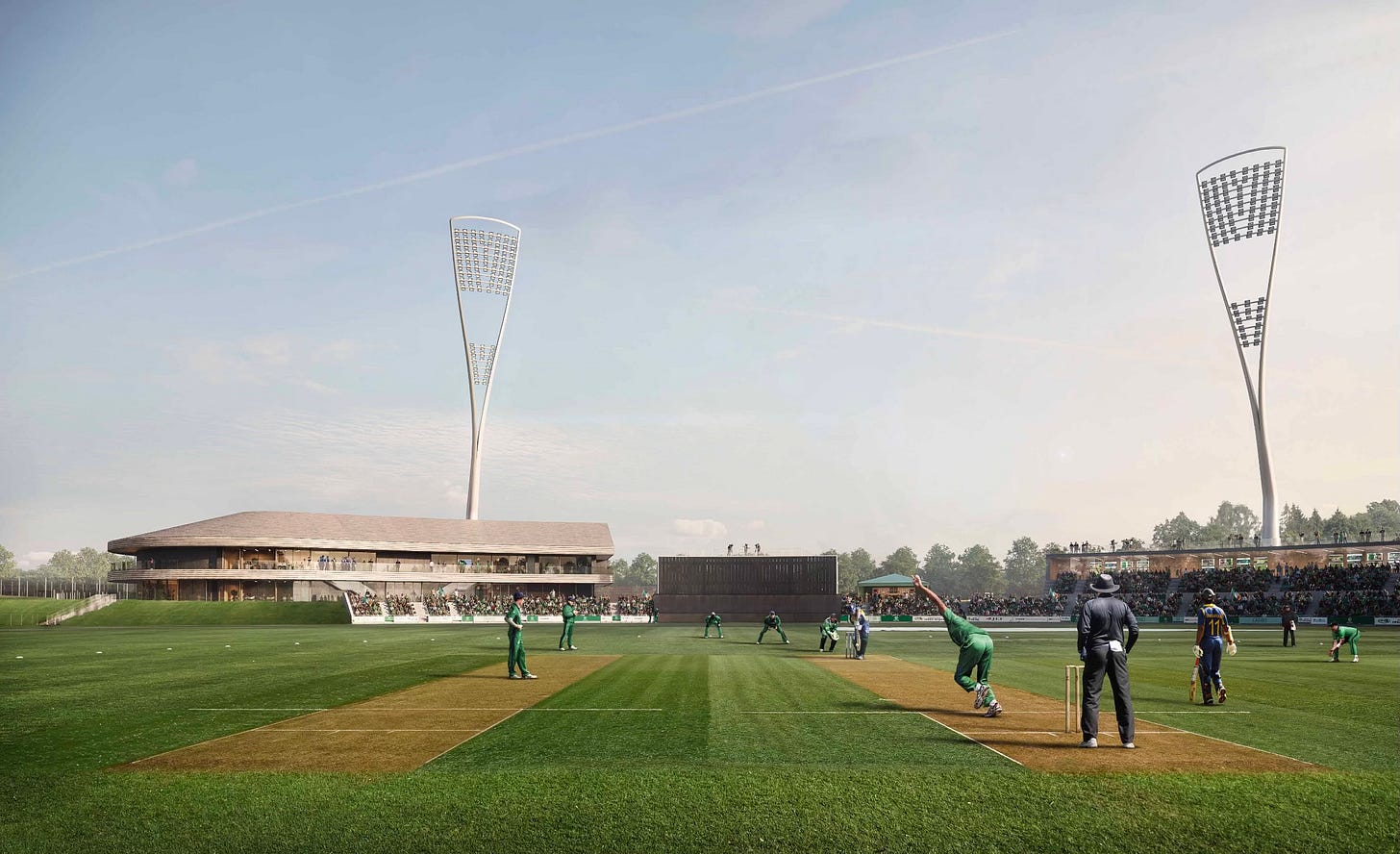
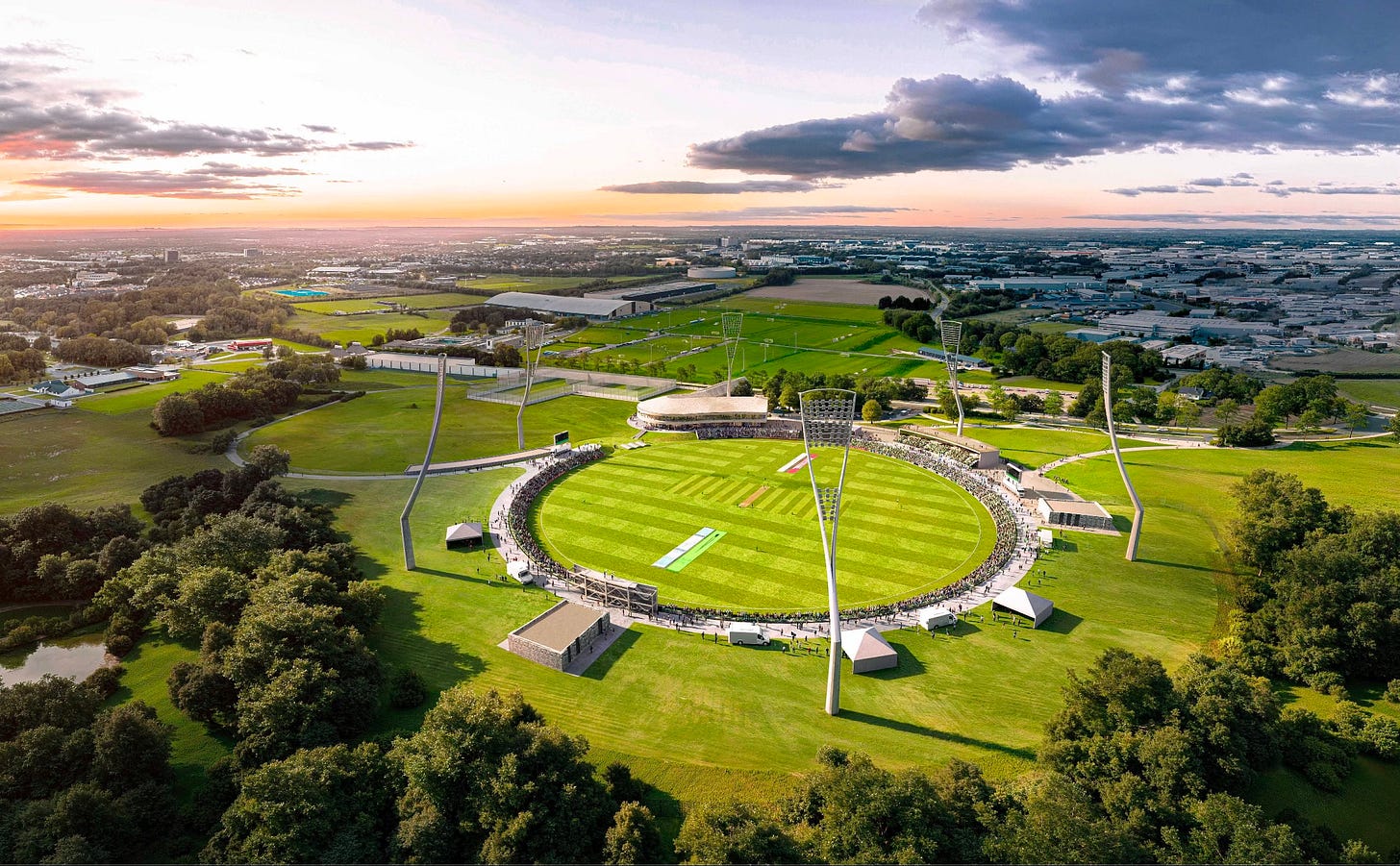
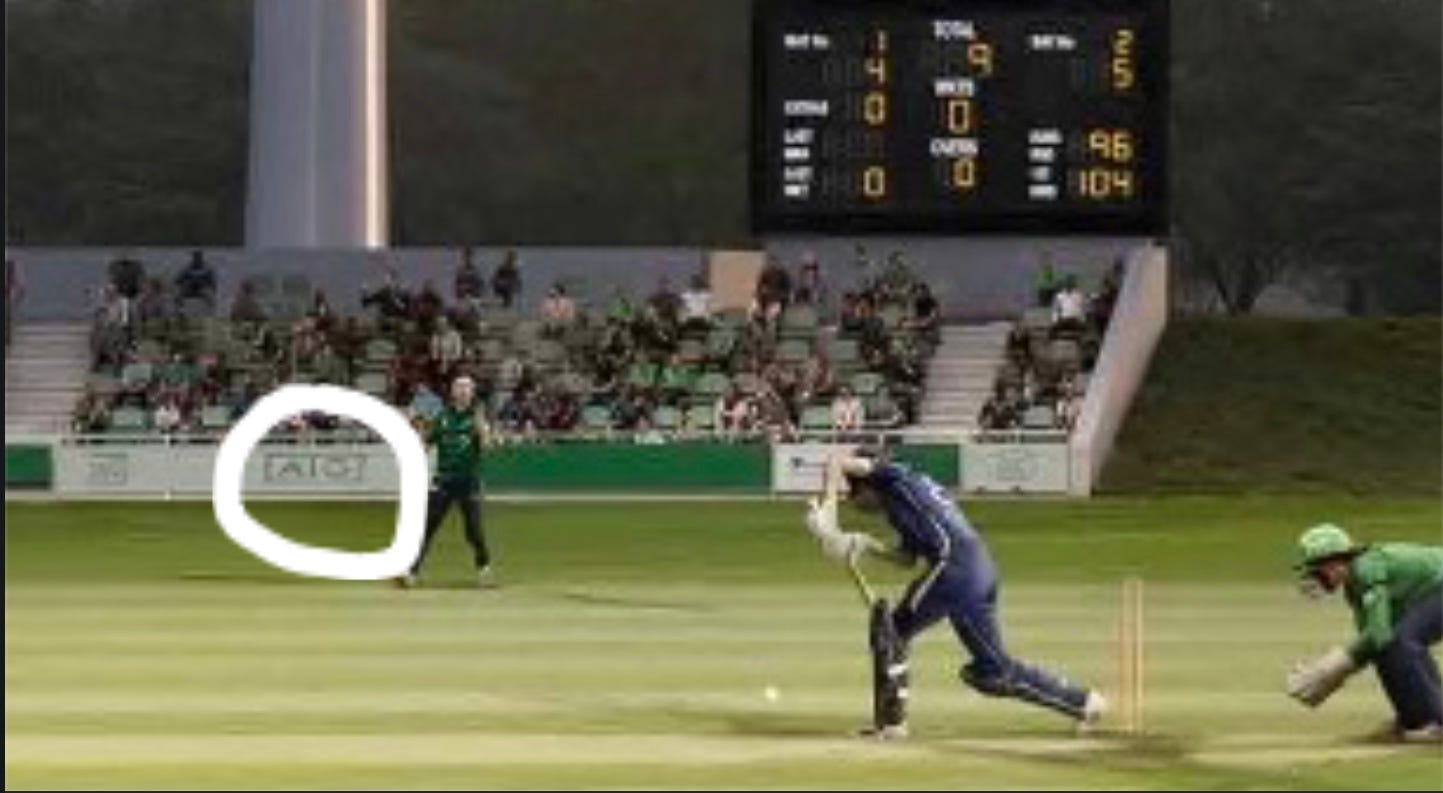
When I first heard about plans to build a modest cricket stadium at Abnotstown, one thing I didn't think would be a problem would be permission, as it is a national sports centre, I assumed (I know) that future development would have built into the original planning permission for the site
A lot of the application seems to involve infrastructure and I am curious as to what other sporting events happen there, and anything with similar projected attendance, I was imagining a double sided stand similar to Headingly's cricket and Rugby league stand.
Transport/ parking problems do not surprise me, it appears to be an out of town site lacking naturally developed transport links, don't imagine the Dart running to Malahide was anything but coincidence. The Rose bowl in Southampton was a one road in and out 20k stadium and it took years to get adequate park and ride scheme
I was fearful that Abbotstown could end up a white elephant or an unloved venue compared unfavorably with Malahide
But a few things have aligned that may avoid this
Firstly the 2030 T20 world cup, it might just take a famous victory for the venue to enter folklore and a place, dispute it's clear connectivity problems, a place where Irish fans want to go, especially if some games are under lights
Secondly, I think (or is it I hope) there is a growing likelihood of a 2 division test structure
And cherry picking others peoples' ideas, if it is over a 4 year cycle Ireland could host a 3 test series every summer against each of their rivals (similarly a 3 test series over the winter)
Play 2 in Abbotstown 1 in Stormont
If they were 4 day tests then this would allow 3 Fri-Mon matches